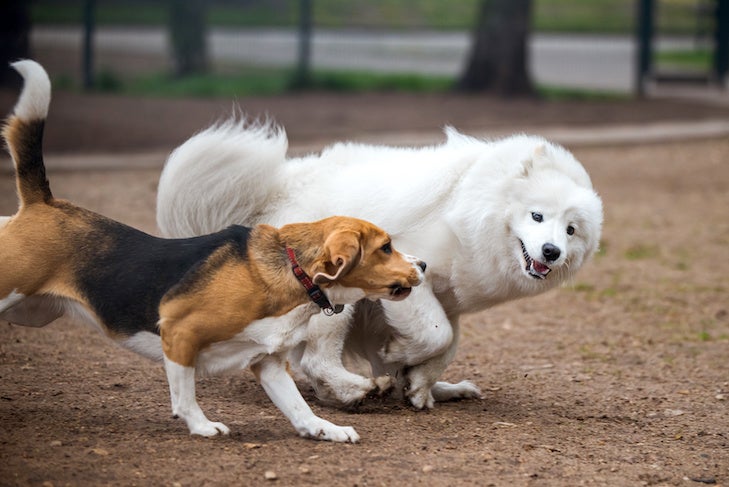
If you’re considering getting a second dog, there are questions you should answer and steps you should take to prepare for the responsibility that comes with training the new dog and helping your current dog adjust.
Questions to Ask Yourself
Before you jump into this new commitment, ask yourself these questions:
- Is your current dog out of puppyhood and completely trained and bonded to you? It’s often more than twice as difficult for one person to train two young dogs at the same time. Young dogs may also bond to each other and be less likely to create as strong a bond with you.
- What’s the age of your current dog? Many breeders recommend that your first dog be at least one-to-two-years old before you add a second to the family. If you have an old dog, they may not be physically able to play with or tolerate a pup.
- What kind of dog do you want to add to the pack? Is your current dog large or small? Do you have space for two dogs, and will you be able to walk two dogs at once? Dogs with similar energy levels make the best companions. Some breeders suggest that opposite-sex dogs get along best.
- Do you have any big events or projects coming up? You may have forgotten how much time is required to dedicate to training and socialization. If your time is limited, wait until your schedule clears.
- Is your family on board? A new dog will change the dynamic of the household, adding more cleaning, time, and money to be spent on dogs, so it’s important that everyone be excited about the new puppy.
- Can you handle the additional cost? You’ll be doubling your financial commitment – twice the amount of food, vet visits, vaccines, grooming, etc. If you’re not prepared for the added expense, don’t get a second dog.
The Wrong Reasons to Get a Second Dog
If the reason for getting a new puppy is among the ones below, it’s best to wait.
- “My dog is fearful, so I want another dog to help him be less anxious and neurotic.” The problem with that reasoning is that dogs can pass their anxieties on to another dog, so then you have two fearful dogs. Work on your dog’s behavior issues first, and then decide if you want to add to your pack.
- “My dog is aggressive with other dogs, so I want to teach him that dogs are nice.” The safety of your new puppy can be a concern if the older dog is aggressive.
- “I don’t really want another dog, but my kids do.” Your kids may be telling you, “I’ll take care of the dog. I’ll do all the work.” Sure they will. Say to yourself, “I will be responsible for a second dog.” If you’re grinding your teeth or sighing a lot, then you probably need to wait a few months and revisit the issue.

How to Introduce the Newcomer
If and when you do get a second dog, here are some tips on making the transition a smooth one.
First, introduce the dogs when they’re on-leash in a neutral place. Read up on dog body language, so you recognize what your dogs are telling you and each other. Let another adult handle one of the dogs, and make sure both dogs are on short, loose leashes. Take the dogs for a walk along a different route than your dog is used to.
Next, if the dogs seem interested and fairly calm, let them walk up to each other. Let them sniff each other. Verbally praise a good interaction, and keep the leashes loose. After a few seconds, distract them with treats and redirect their attention back to you.
When a new puppy or dog comes into the house, let the dogs interact safely with the use of a crate or pen. Alternate with one dog in and one dog out. The crate or pen makes it easy for a dog to visit, but walk away when he’s had enough. Always supervise, even with this setup.
During this process, watch for stiff posture, lip lifting, and staring — behaviors that can precede growling and snapping. If you see these warning signs, give the dogs a break before trying again.
Have a SUPER Start
Until the dogs are acclimated to each other, which could take days, weeks, or months, try using the “SUPER” method.
Supervise: Keep your eyes on both dogs at all times, whenever they are together, until the adjustment period is over. Give each dog separate food and water bowls, and don’t leave food bowls out after mealtime. Don’t give the dogs bones or toys until they prove they get along.
Understand: The puppy was your idea, not your dog’s. In time, with help from the humans in the house, your dog will adjust. Until then, remember to shower the older dog with attention and love.
Pens: Crates, pens, and baby gates will be a sanity saver for you and the dogs. Everyone, including dogs, needs alone time. Also, make sure each dog gets time alone with you to bond every day.
Expect: Your older dog may correct your puppy with a growl or snap from time to time. This is how adult dogs teach puppies social skills. Your job is to supervise so that things don’t get out of hand.
Reinforce: Reward your dog when he shows tolerance for the puppy. If your dog doesn’t move away, growl, or snap when the puppy lies down next to him, say “Yes” and reward with a treat.
Like any training process, introducing, training, and socializing a new dog takes time. Remember to be patient, and if the relationship is consistently rocky, pursue professional dog-training advice.
 This article originally appeared in the award-winning AKC Family Dog magazine. Subscribe today!
This article originally appeared in the award-winning AKC Family Dog magazine. Subscribe today!

